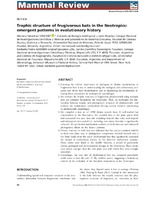| dc.creator | Sánchez, Mariano Sebastián | |
| dc.creator | Giannini, Norberto Pedro | |
| dc.date.accessioned | 2023-01-14T18:18:00Z | |
| dc.date.available | 2023-01-14T18:18:00Z | |
| dc.date.issued | 2018-01-31 | |
| dc.identifier.citation | Sánchez, M. S., y Giannini, N. P. (2018). Trophic structure of frugivorous bats in the Neotropics : emergent patterns in evolutionary history. Revista Mammal News. Londres, Reino Unido: Wiley-Blackwell Publishing ; 48(2), pp. 90-107 . | es_AR |
| dc.identifier.issn | 0305-1838 | |
| dc.identifier.other | CCPI-CNyE-A-013 | |
| dc.identifier.other | 6334 | |
| dc.identifier.uri | https://hdl.handle.net/20.500.12219/4262 | |
| dc.description | Fil: Sánchez, Mariano Sebastián. Consejo Nacional de Investigaciones Científicas. Centro Científico Tecnológico (Nordeste). Instituto de Biología Subtropical; Argentina. | es_AR |
| dc.description | Fil: Sánchez, Mariano Sebastián. Universidad Nacional de Misiones. Facultad de Ciencias Exactas, Químicas y Naturales. Laboratorio de Genética Evolutiva; Argentina. | es_AR |
| dc.description | Fil: Giannini, Norberto Pedro. Consejo Nacional de Investigaciones Científicas y Técnicas. Centro Científico Tecnológico (Tucumán); Argentina. | es_AR |
| dc.description | Fil: Giannini, Norberto Pedro. Universidad Nacional de Tucumán. Facultad de Ciencias Naturales e Instituto Miguel Lillo; Argentina. | es_AR |
| dc.description | Fil: Giannini, Norberto Pedro. American Museum of Natural History. Department of Mammalogy; United States. | es_AR |
| dc.description.abstract | 1. Knowing the relative importance of phylogeny in dietary specialisation in frugivorous bats is key to understanding the ecological and evolutionary processes that drove their diversification and to elucidating the mechanisms allowing their coexistence in multispecific assemblages.
2. We evaluate the trophic structure of frugivorous phyllostomids using multiple data sets collected throughout the Neotropics. Then, we investigate the relationship between trophic and phylogenetic structure of phyllostomids, and evaluate the evolutionary mechanisms driving current resource partitioning in phyllostomid assemblages.
3. We compiled a data set of 14500 dietary records from 24 well-studied bat communities in the Neotropics. We recoded data at the plant genus level and composed two new data sets including tropical sites only, and tropical and subtropical sites pooled (i.e. including sites where diversity is significantly reduced). We performed multivariate analyses on both data sets and estimated phylogenetic effects on the dietary patterns.
4. Dietary structure in both data sets indicated that bat species remained faithful to their core plant taxa. A phylogenetic comparative method selected only a few basal clades from the entire phyllostomid tree that significantly explained the impact of evolutionary history on the observed multivariate patterns.
These clades were dated to the middle Miocene, a period of particularly intense geological and environmental changes in the Neotropics. These clades were always younger than the core plant taxa with which they were strongly associated.
5. Accordingly, the core diet of phyllostomid bats has remained remarkably stable since at least the past 15 My (million years), suggesting a bottom-up control of the evolution of the bat-plant interactions in the Neotropics. | en |
| dc.format | application/pdf | |
| dc.format.extent | 704.4 KB | |
| dc.language.iso | eng | en |
| dc.publisher | Wiley-Blackwell Publishing | en |
| dc.rights | info:eu-repo/semantics/openAccess | |
| dc.rights.uri | http://creativecommons.org/licenses/by-nc-sa/4.0/ | |
| dc.subject | Bat-plant interactions | en |
| dc.subject | Bottom-up control | en |
| dc.subject | Dietary specialisation | en |
| dc.subject | Evolution | en |
| dc.subject | Phyllostomidae | en |
| dc.title | Trophic structure of frugivorous bats in the Neotropics : emergent patterns in evolutionary history | en |
| dc.type | info:eu-repo/semantics/article | |
| dc.type | info:ar-repo/semantics/artículo | |
| dc.type | info:eu-repo/semantics/publishedVersion | |




